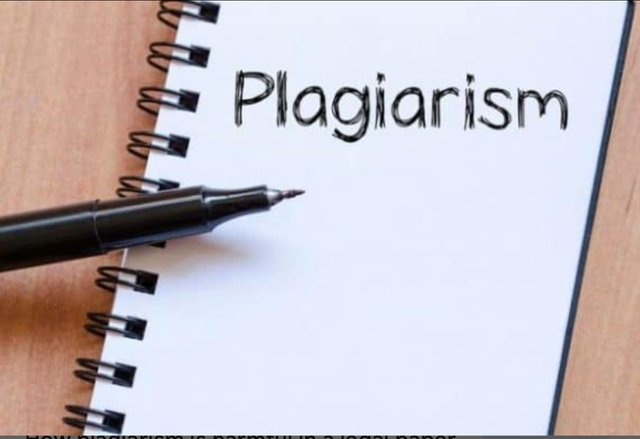ACHIEVEMENT TASK 3 BY: @unbetableken TOPIC: CONTENT ETIQUETTE
PLAGIARISM
Plagiarism is the honest act of trying to pass someone else’s work as your own. It’s the type of an ethical practice that can land writers, editors and academic researchers in big problem.

https://blog.ipleaders.in/plagiarism-harmful-legal-paper/?amp=1
TYPES OF PLAGIARISM
There are seven common types of plagiarism:
MOSAIC OR PATCHWORK PLAGIARISM :
With this type of plagiarism, the work of someone else is simply paraphrased without proper citation. It’s often difficult to detect because the plagiarized material is interwoven with many different sources, including the writers own ideas and perspective.
It can be done from one or several sources. The writer may try to change one or several sources. The writer may try to change up the sentence structure or use synonyms to make it seem original. However, taking the idea of another piece is still plagiarism, even if the words are switched up a bit and intermingled with original thought.PARAPHRASING PLAGIARISM:
Paraphrasing, or incremental plagiarism, is the most common type of plagiarism. It’s similar to the mosaic plagiarism style mentioned above. However, the difference is that the copied work isn’t mixed in the new concepts and research. When you paraphrase the original idea in your own words, the borrowed material stays the same throughout the new piece.
3.COMPLETE PLAGIARISM:
Complete plagiarism is more common in academic writing than in content marketing or other types of online writing. This type of plagiarism occurs when someone tries to submit an entire research paper as their own without proper attribution.
It involves copying and pasting the original work in its exact words. The only thing that is changed is the author’s name.
SELF-PLAGIARISM:
Also known as auto-plagiarism, self-plagiarism happens when you copy your own writing, whether intentional or not. Often the person in a self-plagiarism incident is summarizing or repurposing their own work instead of writing a whole new piece from scratch on the same topic.
Many people think self-plagiarism is harmless because you are not stealing someone else. Just yourself. But, this type of plagiarism can be just as damaging as any other.ACCIDENTAL PLAGIARISM:
Plagiarism doesn’t always happen on purpose. It’s still considered plagiarism when someone copies another’s writing without citing their source, improperly cites the source or leaves out quotation marks on accident. Just because the omission or incorrect citation was accidental doesn’t mean plagiarism hasn’t been committed. This is why it’s important to check any work and when in doubt, give your source credit.SOURCE-BASED PLAGIARISM:
This type of plagiarism refers to instances when misleading sources are involved. For example, the writer may have two sources of information but only reference one. Another form of source-based plagiarism would be when an author quotes a non-existent or incorrect source.
The worst type of this kind of plagiarism is when sources are fabricated. Making up information like study findings or statistics is extremely misleading and can even be harmful in the case of medical content.DIRECT OR VERBATIM PLAGIARISM:
Direct plagiarism, also known as verbatim or copy-paste plagiarism, is an intentional and unethical form of stealing content. As the name suggests, the writing is stolen word for word and pasted into new piece. The author then tries to pass off the content as their own. A word or two might be changed, but this type of plagiarism is too blatant to be considered paraphrasing.
Source https://writer.com/blog/types-of-plagiarism/
SOME CAUSES OF PLAGIARISM
FEAR . Many students lack self-confidence and believe they can’t make the proverbial grade. They don’t want to let themselves, their teachers, or their family down, so they will fall back on plagiarism by way of trying to make their papers look good .
IGNORANCE. Often students are not taught what plagiarism is and how to avoid it.
CULTURAL ISSUES: In some cultures, directly quoting an admired source is seen as form of flattery and respect, not a form of low- grade criminality.
HOW TO CITE A REFERENCE
citing helps writers avoid plagiarism, it’s important for writers to know the act of citing a reference. To show that a sentence or quote is from another author, you will have to use ‘>’ sign and space before the sentence you used from another author.
When trying to source a photo, what you do is this [source] (link of the photo from the site)
Example:

Source https://www.indiamart.com/proddetail/copy-paste-data-entry-service-22099998162.html
A click on the source will direst you to the site where the photo is taken from.
Thank you all for reading
@ cryptokannon
@steemcurator03
@whitestallion
@ngoenyi
@alphafx
Hi, your post contains traces of plagiarism. Please do well to clean it up and make it 100% unique.
Also add the citation example to your post
Alright ma